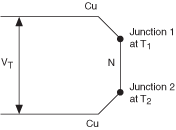Thermal Voltages
Thermal voltages, also known as thermal EMFs, are voltages created by the junction of dissimilar metals when a temperature difference exists between these junctions. The generated voltage increases with temperature. The specific metal-to-metal junctions result in specific temperature coefficients (V/°C) called Seebeck coefficients, which are shown in the following table.
| Junction | Seebeck Coefficient (µV/°C) |
|---|---|
| Copper–Copper | <0.3 |
| Copper–Gold | 0.5 |
| Copper–Silver | 0.5 |
| Copper–Brass | 3 |
| Copper–Nickel | 10 |
| Copper–Lead-Tin Solder | 1–3 |
| Copper–Aluminum | 5 |
| Copper–Kovar | 40 |
| Copper–Copper Oxide | 1000 |
You can determine thermal voltages using the following formula:
VT = K(T2—T1)
where
T1 and T2 are temperatures measured at the junctions of dissimilar metals
K is the Seebeck coefficient of Copper—N (from table above), and N is a dissimilar metal

To reduce the effects of thermal voltages, use clean copper–to–copper connectors with gold-plating.
 |
Note If you are using National Instruments switch modules and you want to know how thermal EMF and offset voltage affect your measurements, refer to the Thermal EMF and Offset Voltage section of the NI Switches Help at either of the following locations:
|